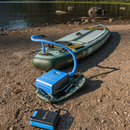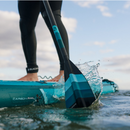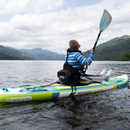What are the Best Wind Conditions for Paddle Boarding?

Whether you're a seasoned paddle boarder or just dipping your toes, grasping wind conditions is paramount. From gentle whispers of air to full-blown gusts, the wind can play a pivotal role in your paddle boarding adventure. Let's unpack which conditions are best, taking into consideration skill level and the important of understanding wind dynamics.
When Is It Too Windy to SUP?
For safety reasons, it's generally too windy for most paddle boarders if wind speeds exceed 25 mph (40 kph). While professionals might take on stronger gusts, for the average enthusiast, this is too much wind for paddle boarding.
What are the Best Wind Conditions for Paddle Boarding?
Let's explore some of the best wind for paddle boarding here:

Ideal Wind Conditions for Beginners
- Flat waters: The charm of calm conditions - Beginners should ideally start on calm, flat waters with little to no wind. This offers a stable platform to learn and hone basic paddle boarding skills.
- Wind speed recommendations for those just starting out would be a breezy 0-5 mph. This range promises a delightful balance of safety and an effortless learning experience.
Ideal Wind Conditions for Intermediate Paddlers
- Challenges and benefits of intermediate wind conditions - good wind for paddle boarding at this level ranges from 5-15 mph. It presents a moderate challenge, helping intermediates improve their skills.
- Techniques to conquer consistent winds - Master the step-back turn and use the paddle as a sail, adjusting the board position to navigate these winds.
Ideal Wind Conditions for Pros
- Harnessing the power of nature: Riding gusts and swells - Professionals often thrive in wind conditions between 15-25 mph. This is the ideal wind speed for them, turning every gust into an opportunity to showcase their expertise.
- Safety measures and techniques for seasoned paddle boarders - Use leashes, wear life vests, and understand wind patterns to navigate stronger winds safely.
Preparing for a Windy Day Out
Before paddle boarding, make sure everything is set up to protect your safety. Consider these tips for paddle boarding on a windy day:
- Before leaving for the day, check the wind forecast. Windfinder is a great source that will tell you the current speed of the wind at the body of water you are heading out to and what to expect the rest of the day.
- Be conscious of your surroundings and the conditions at sea.
- On a windy day, always paddle with a leash.
- On windy days, make sure to put on a PFD.
- If you are paddling far from shore, always bring a VHF radio to call the Coast Guard or other local authorities for help.
- The wind direction matters. You mustn't start your paddle with the wind at your back, which is especially important if you paddle in the ocean and have an offshore breeze.
Understanding Wind Dynamics

Wind Direction
- Onshore Winds: Originating from the sea and moving towards the land, these winds can pose risks to paddle boarders. Approximately 70% of reported paddle boarding incidents occur in onshore winds, as they tend to push participants away from the safety of the shore.
- Offshore Winds: Emanating from the land and blowing towards the sea favor paddle boarding near the beach. However, venturing too far out can be problematic, as offshore winds account for 20% of difficulties faced by paddle boarders in deeper waters.
- Crosswinds: These winds blow directly across your route and can be tricky to handle. Studies have shown that even experienced paddle boarders need to adjust their course every 3-5 minutes in strong crosswinds.
Wind Strength

Light winds under 5 mph won't impact your paddle boarding much. However, wind speeds over 15 mph make paddle boarding more challenging, using up to 30% more of your energy.
Temperature & Thermal Effects
- Sea Breezes: Common in coastal areas in the summer. They happen when the land is about 5°F hotter than the sea, making winds blow from the sea to the land.
- Land Breezes: The opposite of sea breezes. They occur mainly during early mornings or evenings when the land cools about 7°F quicker than nearby waters, causing winds to blow from the land to the sea.
The Impact of Atmospheric Pressure
- Areas of High-Pressure: These areas, where atmospheric pressure is approximately 10% above the average, usher in tranquil and sunlit conditions, crafting an idyllic backdrop for leisurely paddle boarding.
- Areas of Low-Pressure: Harbingers of tumultuous weather, these zones are characterized by an atmospheric pressure roughly 10% below the norm. They can introduce fiercer winds and rains, and beginners venturing out in these conditions face a 60% higher risk of encountering challenges.
The Meaning of Cloud Formations
- Cumulus Clouds: These fluffy, cotton-like clouds usually indicate fair weather but can grow into more giant storm-producing clouds.
- Cirrus Clouds: High-altitude, wispy clouds often indicate that a change in the weather is on the way.
- Cumulonimbus Clouds: Towering clouds are often associated with thunderstorms. If you spot them, it's a sign to get off the water.
Other Elements

- Rain: Light rain might not disrupt your SUP experience, but heavy rain can reduce visibility and make the water choppy.
- Rip Currents: Narrow currents flowing seaward from the shore. They can be dangerous for all water sports enthusiasts, including paddle boarders.
- Lightning & Thunderstorms: If you hear thunder or see lightning, it's time to head to shore immediately. Water is a good conductor of electricity, making SUP during thunderstorms extremely risky.
Finally, mastering paddle boarding skills means you clearly understand the influence of Mother Nature. The wind can be a challenge when you're out on the water. Knowing the best wind conditions for paddle boarding can significantly enhance your SUP experience, whether you're a beginner or an expert.
Want to paddle with the best? Try the iROCKER inflatable paddle board for a top-notch experience and visit the iROCKER Blog for more valuable readings and boost your boarding game!






